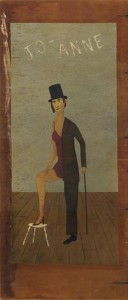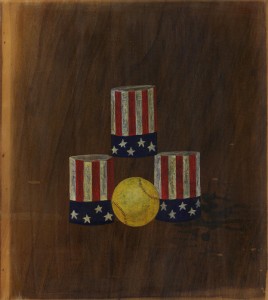Ian Shadwell previews Midgets and Giants a new show by Dean Manning for Art Month 2011…
Dean Manning’s paintings are a curious mixture of naivety and sophistication. This is not so much a case of innocence accidentally revealing the profound as much as it is a sophisticated ambush of his audience with the charming simplicity of his work. His paintings are delicate, detailed oils painted directly onto wood panels. They have an immediacy that comes from the obvious labor and craft of their production. The wood grain often appears through the thinly applied layers of paint. Here and there it even forms the ground against which the figures stand. Everything is rendered with a disciplined, willful strength, as if there should be no ambiguity in their form, yet their is also the impression of delicacy and an allusive, sub-textual play, in which the paintings are rendered as a kind of commentary that has been exchanged between friends.
Dean Manning, Jo-Anne, 2011.
They are very much Australian, exhibiting a determined fascination with our history, culture and place and include narrative works on criminals, pictures of produce from agricultural shows and landscapes of the many places Dean has visited in his travels. But, Australians! don’t cringe. This is no celebration, but rather an acknowledgment of shared experiences. The bush-rangers of the mind, as it were, stealing and then re-distributing the wealth. They’re communicated with a nod and a wink. As I said, these are like conversations between friends. Some things don’t need to be said, to be understood.
It would be easy to refer to this as ironic. But it’s not. It’s iconic, though not in the facile sense of pop immediacy, but rather in the original sense of the Christian Reliquary. Though they may not actually contain the finger of a dead saint, they still record the passing of treasured things – memories, objects, places that have transformed Dean and have in turn been transformed by Dean’s imagination, stripped back to their essence and re-presented as figures for our contemplation.
Dean Manning, Knock ’em down, 2011.
As often as not, these are nostalgic figures. A coin operated red phone. A gangster from the thirties. Lawn bowls. Cricket players wearing white. Without being cinematic they do a similar thing to film, turning the world into memory, honing in on the subject and imbuing it with an emotional life that elevates it with a quality that is not quite conscious.
It is no surprise then to find out that Dean was brought up on the Royal Show circuit, traveling the country with his father and family. Back then the Agricultural Shows were still filled with the good stuff. Boxing tents, freak shows, the dodgems, the tunnel of love, the ghost train. Dean used to wander around them freely. Side show alley was his playground. You can see this not just in the subjects of his work, but in the character of his technique. The painted hoardings of the attractions can be seen in the immediacy of his rendering, which maintains a crude sophistication. Indeed it is this larrikin Australian spirit that was an integral part of the Agricultural shows, where the bush comes to town, that informs Dean’s work. A strange liminal underworld, of side show sleaze and squatter wealth shoved up alongside the Country Women Association’s tea tent and cake decorating prize. If these are reliquaries, then they preserve that spirit. But don’t ask me what it is. Go have a look at the paintings.
Opens March 3, 6pm.
Runs through to March 19.
Damien Minton Gallery


